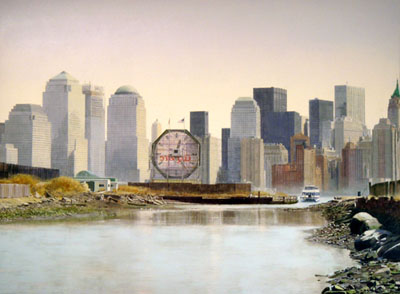Today, 2005 oil on linen, 78 x 105 in Paul Caranicas Yesterday, Today, & Tomorrow Frank Bernarducci and Louis K. Meisel are pleased to announce the exhibition of large scale landscape paintings by Paul Caranicas. This series, entitled "Yesterday, Today, & Tomorrow," consists of three paintings inspired by Thomas Cole's, "Voyage of Life" (ca. 1840; National Gallery of Art, Washington, D.C.), in which four imaginary, panoramic and seasonal landscapes correspond the four stages of human life. In the first of Cole's scenes, an infant glides from a dark cave into a flowering landscape. In Youth, the boy takes control of the boat and aims for a shining castle in the sky. In Manhood, the adult relies on faith to sustain him through rough waters and a threatening, rocky passage; and, in the final scene, an old man is guided by the angel toward eternal light. Caranicas retains the boat motif in his cycle, but adds his own architectural emphasis. The result is more naturalistic overall, while retaining a slightly surreal sensibility. In "Yesterday," the first of Caranicas' series, a solitary boater paddles a yellow kayak up a river in a verdant wood, moving away from the viewer. She approaches an early twentieth-century railroad trestle, evoking Monet at Argentieul and Thomas Eakins on the Schuylkill. Beyond the bridge the winding river bends and, although she cannot see where she is headed, the atmosphere on the other side is bright, symbolizing optimism and hope. Our rower is on a pilgrimage into a transcendent nature, a semi-mystical site of emotional renewal and repair. An allegory of passage is especially evident in "Today," which shows the city in the distance and an approaching ferry in the middle ground, while the left center is occupied by a skeletal octagonal clock, a landmark when seen from the New York City side but here viewed from the back. The artist is recording a crossing that is both mundane and momentous, showing commuters racing the clock in a daily routine and a journey like that of the ferryman carrying souls to their final destination. In addition, the organic shoreline debris contrasts with the top-heavy urban sprawl of Manhattan, recalling the eventual return to nature of all climactic civilizations. The most unsettling painting in Caranicas' triptych is, of course, "Tomorrow". Once again Caranicas has placed us in a transitional space, a kind of desiccated marsh that seems to stretch out in all direction. For this painting, Caranicas has chosen an oblique vista of Atlantic City that includes only a hint of its dominating hotels in the distance and obliterates its common honky-tonk associations. On the left, a racing boat has become a high-tech remnant beached at an equally discarded, once ultra-modern home, while a billboard on high, featuring a Big Brother-like image, seems to announce the arrival of this futuristic ruin. Certainly, the murky waters here suggest loss and vacuity; yet the fledgling shoreline growth and rich sky also convey inevitable recurrence and return. Born in Athens, Greece, Caranicas came to the United States in 1946, the year of his birth. He studied at Georgetown University in Washington, D.C. and went on to study the arts at the Corcoran School of Art as well as the Ecole des Beaux Arts in Paris. Exhibition: 5 - 28 October, 2006 Gallery hours: Tues-Sat 10 am - 5:30 pm Bernarducci Meisel Gallery 37 West 57th Strett USA-New York, NY 10019 Telephone +1 212 593 3757 Fax +1 212 593 3933 Email frankb@meiselgallery.com www.bernarduccimeisel.com |
|
